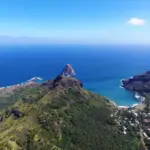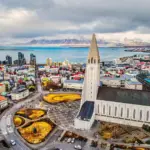Unraveling Geographical Magic: Where the Canary Islands Lie

But where are the Canary Islands? The Canary Islands are an archipelago located in the Atlantic Ocean, near the northwest coast of Africa. This group of islands is an autonomous community of Spain and boasts a strategic location between Europe, Africa, and the Americas. The Canary Islands are known for their rich geographic diversity, stunning volcanic landscapes, stunning beaches, and subtropical climate. This archipelago is a popular tourist destination due to its unique combination of natural beauty and Spanish culture, offering visitors a unique experience at the crossroads of different continents.
Across the vast Atlantic Ocean, where the azure blue meets the vast horizon, the Canary Islands rise like sparkling jewels. Located off the northwest coast of Africa, this spectacular archipelago is comprised of seven main islands, each with its own captivating history and stunning landscapes.
Geographical Location and Historical Importance
The Canary Islands have a unique strategic location that has played a significant role in world history. Located approximately between 27° and 29° north latitude and 13° and 18° west longitude, these volcanic islands emerge from the depths of the Atlantic Ocean about 100 km off the northwest African coast.
This proximity to the African continent has led to mutual cultural, commercial, and historical influence between the two regions over the centuries. The Canary Islands' historical importance dates back to ancient times, when the ancient Phoenicians explored their coasts in search of natural riches.
Later, the Romans harnessed the strategic benefits of these islands as a crucial stopover during their ocean journeys. Furthermore, during the period of European colonization in the Americas, the Canaries became a launching point for transatlantic voyages, playing a vital role in establishing sea routes and spreading diverse cultures.
Overview of the Islands and Their Diversity
Each of the Canary Islands has unique characteristics that differentiate it from the rest of the archipelago, creating a fascinating blend of stunning landscapes. The archipelago is divided into two provinces: Las Palmas, made up of the eastern islands (Gran Canaria, Fuerteventura and Lanzarote), and Santa Cruz de Tenerife, made up of the western islands (Tenerife, La Palma, La Gomera and El Hierro)This diversity is evident in the geographic landscape of the islands.
Tenerife is home to the majestic Mount Teide, Spain's highest mountain, at 3,718 meters above sea level. Gran Canaria surprises with its golden dunes in Maspalomas and its impressive rock formations at Roque Nublo. Fuerteventura captivates visitors with its extensive white-sand beaches and crystal-clear waters, while Lanzarote impresses with its almost lunar-like volcanic vastness.
In short, the Canary Islands are an incomparable geographical and historical treasure. Their unique strategic location off the African coast and the diversity of their landscapes make this archipelago an unmissable destination for those seeking an unforgettable experience amidst the islands' stunning nature and rich history.

Exact location of the Canary Islands
Geographic coordinates and position in relation to the African coast
The Canary Islands are located in the Atlantic Ocean, northwest of Africa. Their approximate geographic coordinates are 28°00′ N latitude and 15°30′ W longitude.
This strategic position places the islands between three main continents: Europe, Africa, and America. Their proximity to the African coast, specifically Morocco, is only about 100 km at the narrowest part of the Strait of Gibraltar.
Distances between islands and nearby major cities
The Canary Islands are made up of seven main islands: Tenerife, Gran Canaria, Lanzarote, Fuerteventura, La Palma, La Gomera, and El Hierro. The distance between these islands varies depending on their geographic location. In terms of sea distance between the two largest islands of the archipelago:
– Tenerife is located approximately 115 km west of Gran Canaria. – Lanzarote is located approximately 280 km northeast of Gran Canaria.
Regarding the distances from the main cities near the respective islands: – Santa Cruz de Tenerife is the capital of the Canary Islands and is located on the island of Tenerife.
– Las Palmas de Gran Canaria is the capital of the province of the same name and is located on the island of Gran Canaria. – Arrecife is the capital of the province of Las Palmas and is located on Lanzarote.
These cities are important urban centers and offer a variety of services and infrastructure for residents and visitors to the islands, as well as serving as jumping-off points for explore the natural beauty of the Canary Islands. The precise geographic position of the Canary Islands, along with the distances between the islands and their main cities, are crucial factors in understanding the region's logistics.
This unique location significantly influences various aspects of the Canary Islands, from climate to tourism. By understanding these geographical details, we can better appreciate the uniqueness of these fascinating islands.

how to get to the Canary Islands
To reach the Canary Islands, you can use various means of transportation, including planes and boats. The main ways to reach the islands are:
- Plane: The most common way to reach the Canary Islands is by plane. There are direct flights from several European cities, such as Madrid, Barcelona, London, Paris, and Frankfurt, as well as domestic flights from other Spanish cities. Flight times vary depending on the departure city, but on average, they last about 2 to 4 hours.
- Boat: Another option is to reach the Canary Islands by boat. Several companies offer ferry services between the islands, as well as connections to the African mainland. However, this option can be slower and less frequent than flying.
- Route between the islands: for those who wish to visit more than one island, it is possible travel between them by plane or by ferry. All islands have airports and ports, making travel between them easier.
It is important to check entry restrictions and requirements regarding the COVID-19 pandemic before traveling to the Canary Islands.
how to get to the canary islands from brazil
To reach the Canary Islands from Brazil, there are no direct flights. You'll need to make a connection in another country, such as Portugal or Spain. One option is to fly to Madrid and then take another flight to the Canary Islands.
- 1. The flight time from Madrid to Gran Canaria, for example, is about 2 and a half hours.
- 2Some airlines that offer flights to the Canary Islands are TAP AIR PORTUGAL, Air Europa and Iberia
- 3It is also possible to reach the Canary Islands by boat, but this is a less common option.
what to do in the Canary Islands
With white sand beaches, turquoise seas, and stunning natural landscapes, the islands offer a wide range of activities for tourists. Below are some suggestions for what to do in the Canary Islands:
- Visit the National park Teide, in Tenerife, home to the El Teide volcano, the highest point in Spain.
- Discover the white or black beaches, depending on the island, such as Maspalomas Beach in Gran Canaria.
- Stargaze under the clearest night sky in Europe.
- Explore the dunes of Maspalomas, in Gran Canaria.
- Discover the Port of Puerto de Mogan, in Gran Canaria.
- Windsurfing at Sotavento Beach in Fuerteventura.
- Visit the Canary Islands Botanical Garden, in Gran Canaria.
- Visit the Museum of Contemporary Art of Santa Cruz de Tenerife, in Tenerife.
- Take a boat trip to spot dolphins and whales.
- Try the local cuisine, such as mojo, a typical Canary Islands sauce.
Furthermore, it is important to remember that each island has its own attractions and peculiarities, so it is worth researching each one before plan the trip.

Canary Islands Archipelago
The Diversity of the Canary Islands – A Geographical and Biological Treasure
The Canary Islands are a volcanic archipelago located in the Atlantic Ocean, off the northwest coast of the African continent. Comprising eight main islands and several smaller islets, the archipelago is known for its unique geographic and biological diversity. These characteristics make the Canary Islands a true treasure for lovers of nature and unique ecosystems.
Total Number of Islands and Classification into Groups
The Canary Islands archipelago consists of eight main islands, each with its own distinct geographic characteristics. These islands are divided into two groups: the western group, consisting of El Hierro, La Palma, La Gomera, and Tenerife; and the eastern group, consisting of Gran Canaria, Fuerteventura, Lanzarote, and La Graciosa. In addition to these eight main islands, there are also several small islets that complement the archipelago's natural beauty.
Group of Islands
The western group of the Canary Islands is characterized by its spectacular mountainous landscape. El Hierro is the smallest of the four islands in this group, known for its pine forests and underwater beauty. La Palma, also known as "La Isla Bonita," is famous for its dormant volcanoes and the lush vegetation of its Biosphere Reserve.
La Gomera, with its dense laurel forest and impressive gorges, is a hiker's paradise. Finally, Tenerife is the largest island in the archipelago and is home to the majestic National park of Teide, declared a World Heritage Site by UNESCO.
In the eastern group of the Canary Islands, we find Gran Canaria, an island with a wide variety of landscapes, ranging from golden sand dunes to imposing mountain peaks. Fuerteventura is famous for its endless white-sand beaches and crystal-clear waters, making it a popular destination for water sports enthusiasts.
Lanzarote offers a unique volcanic landscape with its many fascinating geological formations and impressive national parks. Finally, the small island of La Graciosa enchants with its deserted beaches and tranquil atmosphere.
In short, each island in the Canary Islands archipelago has unique characteristics that make them unmissable destinations For those who love nature and geographic diversity. From majestic mountains to paradisiacal beaches and impressive volcanic formations, the Canary Islands offer an unparalleled experience for all travelers seeking natural adventure.
Tenerife: The Pearl of the Canary Islands Archipelago
Tenerife, the largest and most populous island in the Canary Islands archipelago, is a true treasure for nature lovers and those seeking stunning tourist destinations. One of the island's most impressive highlights is the National park Mount Teide, a UNESCO World Heritage Site that is home to Spain's highest peak.
At an altitude of 3,718 meters above sea level, Mount Teide offers stunning panoramic views that leave visitors awestruck by its immensity and indescribable natural beauty. Tenerife also stands out for its unique geographical features, such as the Sierra de Anaga.
This rugged mountain range stretches along the island's northeast coast and has been declared a UNESCO Biosphere Reserve. With its steep cliffs covered in dense laurel forests, the Serra de Anaga offers challenging trails and stunning views of the Atlantic Ocean.
Gran Canaria: A Tapestry of Lush Landscapes
Gran Canaria, the second largest island in the Canary Islands, is known for its astonishing variety of landscapes that enchant visitors. One of the island's most famous tourist attractions is the Maspalomas dunes. Located on the south coast, these golden dunes are a true natural wonder.
Visitors can hike among the sand hills, explore the unique flora and fauna, and enjoy the beautiful beaches surrounding this area. Beyond the dunes of Maspalomas, Gran Canaria boasts a diverse geography that includes impressive rock formations such as Roque Nublo and Roque Bentayga.
Both are imposing volcanic monoliths that offer incredible panoramic views of the surrounding landscape. The island is also home to lush green valleys, such as the Agaete Valley, home to coffee plantations and vineyards.

Conclusion
The Canary Islands are a true paradise for travelers seeking stunning natural adventures. Tenerife impresses with the majestic presence of Mount Teide and the enchanting landscapes of the Sierra de Anaga.
Gran Canaria, in turn, seduces visitors with its famous dunes and diverse scenery, combining spectacular rock formations, lush valleys, and pristine beaches. These two main islands of the archipelago offer experiences unique experiences that will certainly enrich any trip to the Canary Islands.
Lucas Wanderlust has a tireless spirit of adventure, always seeking new travel experiences. Fascinated by the world and the possibility of exploring unknown destinations, he fell in love with the sense of freedom and self-discovery that traveling alone provides. With a backpack on his back and a heart open to the unknown, Lucas embarks on exciting journeys, where each destination becomes a unique chapter in his life story. He gives himself body and soul to the magic of solo travel, inspiring others to follow in his footsteps and discover themselves through adventure.







